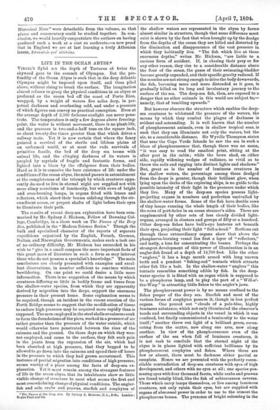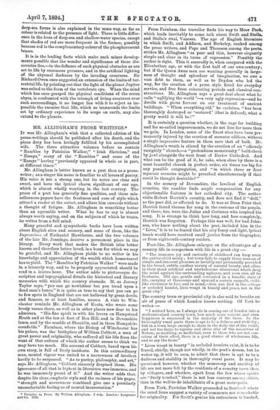LIFE IN THE OCEAN ABYSS.*
VIRGIL'S Sybil set the depth of Tartarus at twice the skyward gaze to the summit of Olympus. But the pro- fundity of the Ocean Abyss is such that in the deep Atlantic Olympus might be imposed upon itself, and Ossa piled above, without rising to break the surface. The imagination almost refuses to grasp the physical conditions in an abyss so profound as the ocean bed off the coast of Porto Rico, wrapped, by a weight of waters five miles deep, in per- petual darkness and everlasting cold, and under a pressure of which figures can convey no practical conception. Even at the average depth of 2,500 fathoms sunlight can never pene- trate. The temperature is only a few degrees above freezing- point, the water is without movement, there is no plant-life, and the pressure is two-and-a-half tons on the square inch, or about twenty-five times greater than that which drives a railway train. Yet it is now certain that where the fancy painted a survival of the sterile and lifeless plains of an unformed world, or at most the rude survivals of primitive fossils, the bed of the deep sea teems with animal life, and the clinging darkness of its waters is peopled by myriads of fragile and fantastic forms, and lighted into a blaze by the effulgence from their bodies. Hard as it is to conceive the bare existence of life under the conditions of the ocean abyss, the mind pauses in astonishment at the completeness of the triumph by which creatures appa- rently doomed to live in eternal night are supplied not with mere slimy secretions of luminosity, but with rows of bright and ever-burning lamps, in organs fitted with lenses and reflectors, which shoot their beams sidelong through the cir- cumfluent ocean, or project shafts of light before their eyes to illuminate their path.
The results of recent deep-sea exploration have been sum- marised by Mr. Sydney .T. Hickson, Fellow of Downing Col- lege, Cambridge, in a short work on The Fauna of the Deep Sea, published in the "Modern Science Series." Though the bulk and specialised character of the reports of separate expeditions organised by the English, French, German, Italian, and Norwegian Governments, makes such a task one of no ordinary difficulty, Mr Hickson has succeeded in his wish to "give in a small compass the more important facts of this great mass of literature in such a form as may interest those who do not possess a specialist's knowledge." The main conclusions are clearly presented with examples and excel- lent illustrations, in number sufficient to convince without bewildering. On one point we could desire a little more information. There is no suggestion of the means by which creatures differing so little in bodily frame and tissue from the shallow-water species, from which they are apparently derived by migration into the deeps, support the enormous pressure in their present home. Some explanation seems to be required, though an incident in the recent erection of the Forth Bridge seems to suggest that the modification of tissue to endure high pressure may be acquired more rapidly than is supposed. The men employed in the steel shells or caissons sunk to form the foundations of the piers, worked in a pressure of air rather greater than the pressure of the water outside, which would otherwise have penetrated between the rims of the caissons and the ground. On those days on which they were not employed, and came to the surface, they felt such pain in the joints from the expansion of the air, which had been absorbed at high pressure, that they begged to be allowed to go down into the caissons and spend their off hours in the pressure to which they had grown accustomed. This instance of partial migration into conditions of high pressure, seems worthy of a place among the facts of deep-sea ex- ploration. Yet it must remain among the strangest features of life in the ocean abyss, that its inhabitants show so little visible change of structure to meet what seems the first and most overwhelming changeof physical conditions. The angler- fish and eels, crabs and prawns, starfish and zoophytes of • The Fauna of the Beep Sca. By Sydney J. Hickson, MA-, D.Sc. London : Regan Paul and Co.
the shallow waters are represented in the abyss by forms almost similar in structure, though that some difference must exist is shown by the fact that when brought up by the dredge from the depths of the ocean they are killed and distorted by the diminution and disappearance of the vast pressure in which they habitually live. "The fish which live at these enormous depths," writes Mr. Hickson, "are liable to a. curious form of accident. If, in chasing their prey or for any other reason, they rise to a considerable distance above the floor of the ocean, the gases of their swimming-bladder become greatly expanded, and their specific gravity reduced. If the muscles are not strong enough to drive the body downwards,. the fish, becoming more and more distended as it goes, is gradually killed on its long and involuntary journey to the surface of the sea. The deep-sea fish, then, are exposed to a danger that no other animals in this world are subject to,— namely, that of tumbling upwards."
But however obscure the structure which enables the deep- sea creatures to withstand the pressure of the waters, the means by which they combat the plague of darkness in evident and astounding. It is well known that the number of phosphorescent animals, even in shallow tropical seas, is such that they can illuminate not only the waters, but the air, to a considerable distance. Sir Wyville Thompson states that near the Cape Verde Islands he saw the sea in such a blaze of phosphorescence that, though there was no moon, "it was easy to read the smallest print, sitting at the after port in the cabin; while the bows shed, on either side, rapidly widening wedges of radiance, so vivid as to throw the sails and rigging into distinct lights and shadows." But, great as is the number of luminous creatures in the shallow waters, the percentage among those dredged from the deeps is greater, though their brilliant glow, when lying upon the decks of the exploring ships, is no guide to the possible intensity of their light in the pressure under which they live. Many of the deep-sea species possess light.. projecting organs in numbers and perfection unrivalled by the shallow-water forms. Some of the fish have double rows of tiny lamps running the whole length of their bodies, like the rows of port-holes in an ocean steamer's sides. These are supplemented by other sets of less clearly divided light.. organs, arranged in clusters and groups of fifty or a hundred. Other deep-sea fishes have bull's-eye lanterns set beneath their eyes, projecting their light " full-a-head." Sections cut through these extraordinary organs show that above the phosphorus-burning vessel lies first a layer of "reflectors," and lastly, a lens for concentrating the beams. Perhaps the strangest development of this power of illumination is in an angler-fish found at a depth of 14,700 feet. Like the other "anglers," it has a huge month armed with long uneven teeth and a pendent " fishing-rod " tentacle which attracts other fish like a bait. In the shallow-water " anglers " this tentacle resembles something edible by fish. In the deep- water species it is fitted with an organ which is supposed to be a phosphorus lamp, and to play the part of a " the-Wisp" in attracting little fishes to the angler's jaws.
The phosphorescent power is by no means confined to the fishes proper of the deep sea. Starfish and most of the various forms of zoophytes possess it, though in less perfect organs. One poured out "clouds of a pale-blue, highly luminous substance, which not only illuminated the observer'S hands and surrounding objects in the vessel in which it was confined, but finally communicated a luminosity to the water itself ; " another threw out light of a brilliant green, coil:m- eeting from the centre, now along one arm, now along another. In view of the phosphorescence even of the surface of the sea when fall of luminous creatures, it is not rash to conclude that the eternal night of the abyss is in places lighted with sufficient brilliance by its phosphorescent zoophytes and fishes. Where these are few or absent, there must be darkness either partial or complete. Hence we are presented with the perfectly recon- cilable contradiction of deep-sea creatures with eyes of high development, and others with no eyes at all ; one species pos- sessing eyes with four thousand facets, while crabs and prawn& are found totally blind, like the fish of subterranean caverns. Those which carry lamps themselves, or live among luminous creatures, not only retain their eyes, but are supplied with organs of abnormal power in order to use to the utmost the phosphorous beams. The presence of bright colouring in the
deep-sea forms is also explained in the same way, so far as colour is related to the presence of light. There is little differ- ence in the hues of deep-sea and shallow-water species, except that shades of red are more frequent in the former, possibly because red is the complementary colour of the phosphorescent beams.
It is in the leading facts which make such minor develop- ments possible that the wonder and significance of these dis- coveries lies,—in the defiance of such physical, obstacles as are set to life by enormous pressure, and in the artificial lighting of the abysmal darkness by the invading creatures. Sir Richard Owen once suggested an extension of the limits of ter- restrial life, by pointing out that the light of the planet Jupiter was suited to the form of the vertebrate eye. When the mind which has once grasped the physical conditions of the ocean abyss, is confronted with the triumph of living creatures over such surroundings, it no longer lies with it to reject as im- possible the surmise that life, which so transcends the limits set by ordinary experience to its scope on earth, may also extend to the planets.







































 Previous page
Previous page